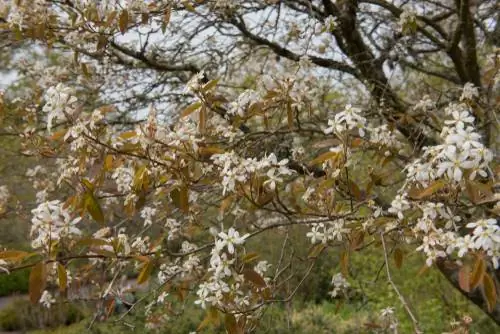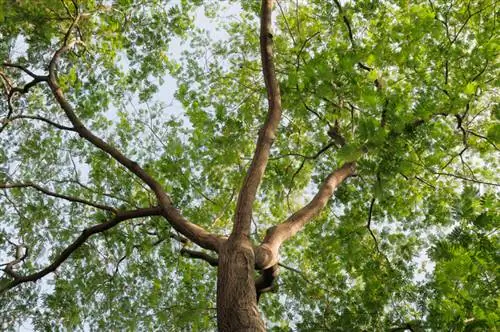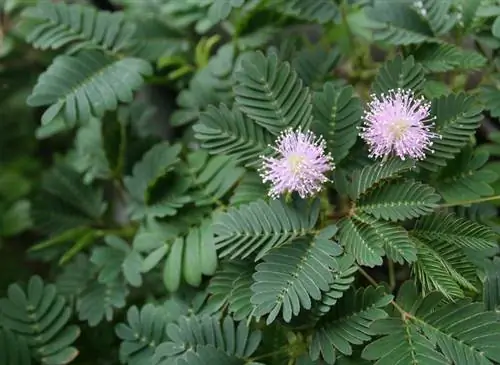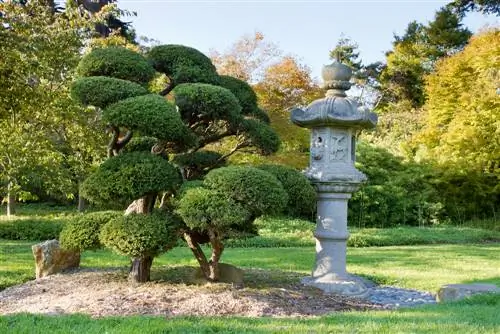- Author admin [email protected].
- Public 2023-12-16 16:46.
- Last modified 2025-06-01 06:02.
White flower fairytale in April, black-blue, edible berries in late summer and bright foliage color in autumn make the rock pear a jewel for the home garden. Creative home gardeners appreciate the pruning tolerance of an Amelanchier. The individual cut gives the ornamental and fruit trees completely different appearances. This tutorial will familiarize you with proper pruning for long-term preservation as a shrub or small tree.
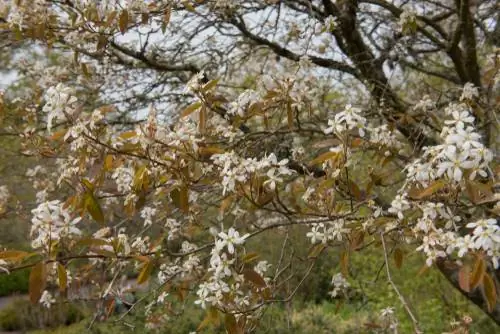
How do you cut a serviceberry correctly?
To properly prune a serviceberry, carry out an annual thinning pruning in late February to early March. Remove old ground shoots and slim down strong branches. To train a tree, choose the strongest shoot as the trunk and direct it to the desired height.
Recommended cutting types and dates
The pruning-technical formability of a serviceberry inspires imaginative home gardeners tovarious forms of cultivation The flower-rich fruit tree can either thrive as a shrub or tree in the garden and adapts flexibly to the available space. The following table summarizes tried-and-tested cutting types with information on the best time:
| Cut style | Goal/Occasion | best date |
|---|---|---|
| Three cutting shrub | Maintaining flower splendor and fruit yield | End of February to beginning of March |
| Educational pruning tree | Educating the little tree | End of February to beginning of March |
| Rejuvenation cut | rejuvenate aged rock pears | Late winter (January to February) |
Thinning out the rock pear bush every year
When it comes to the longevity of flowering wood, rock pears are ahead. In contrast to classic spring bloomers, such as forsythia or weigela, even old branches of the pear tree bear a sea of white star blossoms. This reduces pruning care to anannual thinning cut so that the shrub thrives in light and has a dense coat of leaves deep into the center. You decide the extent of the cut yourself. You can either completely remove individual ground shoots or just slim down heavily branched tips. How to properly prune a serviceberry bush:
- The best time is in February on a mild, frost-free day
- Using a saw (€38.00 at Amazon) or two-handed pruning shears, cut off at least two of the oldest ground shoots at the base
- In exchange, leave the two strongest, unbranched ground shoots standing
- Short the remaining shoots from the rootstock from last year down to the base
- If necessary, cut back or slim down remaining scaffold shoots using a derivation cut
The image below illustrates the cut on the older rock pear bush. Thinning is not necessary in the first 6 to 10 years because a ground shoot remains flowering over this period. A rock pear has the most magnificent abundance of flowers on its two-, three- and four-year-old shoots. The flower splendor on older scaffold shoots is still worth seeing until it gradually fades away and makes the first thinning cut sensible.

Light out the two oldest ground shoots every February. If heavily branched shoot tips lean towards the ground, slimming them down provides relief. Direct these scaffolding shoots to an outward-facing side shoot further back.
Skillfully correct height growth - this is how the lead cut works
Home gardeners are often tempted to control the height of a serviceberry by shortening the shoots at any point. As a result, strong sprouting occurs below the intersection points. Over the years, thick, massively branched broom heads develop on the tips of the shoots, which pull the entire branch to the ground. The formerly slender, tightly upright flowering bush is literally falling apart. Instead of struggling with the unnatural appearance, you should correct the height and appearance of your rock pear with askillful derivation cut. This is how the plan works:
- After thinning, prune any remaining ground shoots with strongly branched heads
- Choose a young, outward-facing side shoot as the cutting point
- Cutting at the junction of old and young wood
A positive side effect of local rejuvenation and slimming is expert height control without creating an unsightly gap in the bush. A further advantage of cutting in February is that you can see theswelling flower budsso that youdon't cut in these places
Background
Responsible gardeners prune before March 1st
Traditionally, early flowering shrubs are cut after the flowering period if necessary. This does not apply to the deep clearing cut of a rock pear. When the furious flower show comes to an end in May, our birds' breeding season has long since begun. Prudent gardeners now leave their scissors and saws in the natural garden so as not to disturb their feathered friends while they are starting a family. The Federal Nature Conservation Act emphasizes this requirement by limiting extensive tree pruning to the period from October 1st to February 28th.
Train rock pear into a small tree
If you are patient, the serviceberry will delight you in later years as amulti-stemmed small tree, without prior pruning training. Given a leisurely growth rate of 20 to 25 centimeters per year, this process can take a long time. It's quicker if you professionally train a young bush to become a tree. With this cut you can do it:
- The best time is every year in February
- On the day of planting, select the strongest shoot as the future trunk and tie it to a support post
- Remove remaining ground shoots as well as side branches along the central shoot
- Guide the center shoot to the desired height on the support post and tie it regularly
- Cut off competitive shoots at the base
- Cut back side branches sprouting from the central shoot to just before the bark
To initiate branching to the crown, please wait until thecentre shoot tip is at least 4 budsabove the desiredcrown base located. The leading branches sprout below the interface and act as a framework for the crown. Please note that trunk growth in height is almost completely complete as soon as the top buds are no longer present.
Excursus
Cut the middle shoot at the right time - this is what you should pay attention to
In the plant kingdom, the law of top support rules, which gives the gardener security when training a serviceberry. A middle shoot continues its upward growth unabated as long as it has its top bud. Because this is the spot where sunlight travels most quickly, the rock pear pumps most of its nutrients there. Buds that are planted deeper down are at a disadvantage. Only when you cut off the tip of the central shoot will the branching to the crown begin because the sap pressure is now distributed more evenly. Therefore, please consider carefully when to cut off the top stem bud. There should be at least 4 buds, or 20 to 30 centimeters, between the tip bud and the desired crown base when the scissors are used.
Rejuvenate an aging shrub or tree
Without a thinning cut, the rock pear turns into a dense, barren network of over-aged, rotten branches. Since the massively thickened shoots shade each other, leaves, flowers and fruits are in short supply in the tree. A rigorous rejuvenation cut turns back time and paves the way for the rebuilding of your rock pear. How to do it right:
- Clear out all dead wood in advance
- Cut off two to three quarters of the remaining scaffold shoots on Astring
- Short remaining ground shoots by a third or half by diversion
As illustrated in the figure below, successful rejuvenation involves the combination of thinning and pruning using derivation. The subsequent shoots provide an excellent basis for rebuilding your rock pear.
Frequently asked questions
I read in a forum for hobby gardeners that the berries of a serviceberry are slightly poisonous. Is that true?
The berries of a serviceberry are definitelynot poisonous In fact, you can not only prepare the black-blue fruits into fruity jam or refreshing compote, but also snack on them fresh from the bush. Experts even consider the berries of the Saskatoon variety (Amelanchier alnifolia) to be a superfood due to their high content of vitamins, minerals and antioxidants. Only the seeds should not be chewed and swallowed as they contain glycosides, which in large quantities can cause nausea. If left unchewed, the seeds pass through the stomach and intestines without causing any discomfort, similar to apple seeds.
Does the rock pear thrive as a shrub or tree?
In a true serviceberry (Amelanchier rotundifolia ssyn. Amelanchier ovalis) is a multi-stemmed shrub. Within the rock pear genus, this is the only native species and is therefore robust and hardy. Over the years, the flowering and fruit tree reaches a height of 300 centimeters with slightly overhanging branches. The popular copper rock pear (Amelanchier lamarckii) stretches 600 centimeters towards the sky and is just as wide. Over time, the large shrub thrives as a small, multi-stemmed tree. Grafted varieties such as Amelanchier Princess Diana serviceberry are available in tree nurseries as a shrub or fully trained standard tree. The non-native rock pear Amelanchier arborea, which is native to North America and grows to a height of 6 to 8 meters, thrives naturally as a multi-stemmed tree.
Is the serviceberry self-fruitful or are additional specimens required for the shrub to bear fruit?
All types and varieties of serviceberry thrive as self-fruitful fruit trees. As a solitary plant, the shrub gives you numerous black-blue berries in autumn. By planting a second variety in close proximity, the yield can be significantly increased.
The 3 most common cutting mistakes
A bare, rotten serviceberry with broom-like shoot tips is the result of typical misunderstandings in pruning care. The following table lists the three most common cutting errors, points out characteristic damage patterns and gives tips for prevention:
| Cutting errors | malicious image | Prevention |
|---|---|---|
| never photographed | bare growth, few flowers and berries | carry out annual thinning cut |
| shoots that are too long arbitrarily shortened | Broom-like branching shoot heads, bush falls apart | always shorten using a lead cut |
| Middle shoot pruned too early during training pruning | puny tall stem | Prune the tip bud on the central shoot at the earliest 4 buds above the base of the crown |
Tip
If the first rock pear decorates the garden, there is no need to purchase additional young bushes. Head cuttings cut in early summer root within a few weeks in a nursery pot or partially shaded, protected propagation bed. Just in time for the best planting time in autumn, the offshoots have transformed into vital rock pears that you can plant in the intended location.

